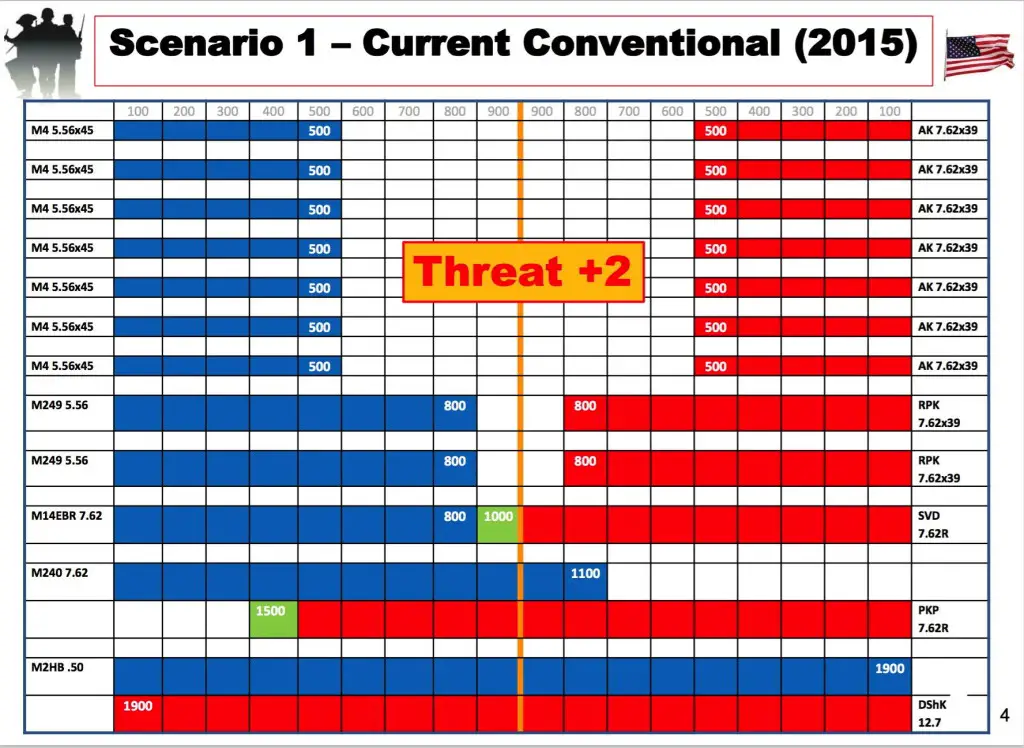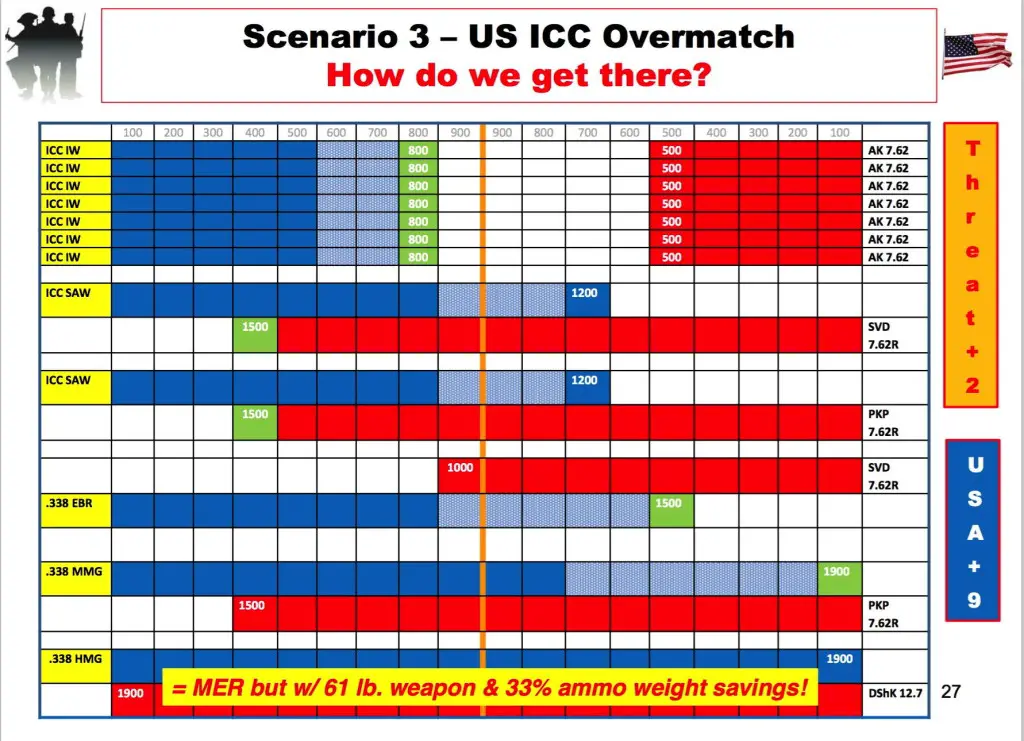Jim Schatz, former HK USA manager (during the period of peak Because-You-Suck-And-We-Hate-You customer service, actually) always has one of the most interesting presentations when he’s up at an NDIA1 conference. The slides from this years’ NDIA are up (here), and Jim’s presentation, interesting as ever, is up here (.pdf). Jim wants us launching bigger bullets, to longer ranges.
Jim’s basic beef is probably best encapsulated in this quote from an SF team sergeant:
Few enemies would even consider taking America on in a naval, air or tank battle but every bad actor with an AK will engage with U.S. forces without even a second thought.
To boil down his argument to a single-sentence thesis: The US lacks small-arms overmatch, and only changing cartridges can get it for us. He defines overmatch by effective range. As he sees it, this is what the world looks like today:
As a former infantryman, Jim knows that weapons don’t square off one-against-one. On the battlefield, units from corps to squad size all maneuver to bring their organic, attached and support firepower to bear on the enemy (who is doing the same, inversely). It’s a common fallacy that (for example) because every squad in the Ruritanian army has a designated marksman, our squads should have one too. (Maybe they should, but not directly because of what the Ruritanians are doing). As you can see, Jim’s focus on range leads him to pair off sniper rifles with light machine guns, weapons which have similar effective ranges for completely different reasons, even when they fire dimensionally identical ammo.
As far as his 1000m effective range of the SVD is concerned… he must have shot one?
Here is one of his proposals for overmatch. There’s a few things screwy here (the SVD has grown an even-more-ludicrous 500m of range, to 1500m), but that’s not important. What is important is the argument that going to an Intermediate Caliber Cartridge (something like the 6.5 or 6.8 or something all new in the 6-7mm neighborhood) for rifles and to .338 for support weapons will provide significant range overmatch.
The increased ammo weight can be made up in part by polymer or semi-polymer (i.e. with a metallic base) cases.
Jim at least partially neutralizes the cost-in-times-of-drawdown argument by suggesting that the new weapons go only to the tip of the spear, the guys whose mission it is to produce casualties, and take and hold ground, with these weapons. That’s only about 140k actual shooters out of the much larger service. A finance clerk needs a rifle, sure, but he or she can live with the latest-but-one.
Bear in mind that the target set is also not static, while we’re developing all these new weapons the Russians, the Chinese, and even the ragtag insurgents of the world (who have definitely, like Russia, pushed more 7.62mm weapons down to squad-equivalent level than heretofore) are acting, adapting, and changing, too. We don’t need to overmatch the enemy today with the weapons we’ll have in ten years. We need to overmatch the set of weapons the enemy will have ten years from now, in ten years.
Men can disagree about how best to get there. Assuming we stick with the M16/M4 platform, Our Traveling Reporter would have us go to the 6.8 x 43. (It was news to him that the Saudi Royal Guard has adopted this platform, in LWRC carbines, or that military 6.8 is in production for export now by Federal — formerly ATK). We would probably go with the 6.5 (x38, although the length designator is seldom spoken aloud) Grendel for its lower BC and higher sectional density (=longer effective range, flatter trajectory, more energy on target). The 90 grain Federal load in the 6.8 is very effective closer in (the 6.8 was developed with SF input as a CQB cartridge).
Some current contenders — M855A1 5.56; 6.5 Grendel; 6.8 SPC; 7.62 NATO. From an excellent article by Anthony Williams setting out assault rifle ammo in historical context, including many old, obscure, and outright forgotten attempts. Shape of the 6.5 suggests a superior BC. The 6.8 is compromised by its 5.56 ancestry and packaging (bolt head size/overall length).
This is not an entirely new or novel idea. As mentioned in the caption to the photo above, British researcher Anthony Williams has a very fine article on Assault Rifle History with lots and lots of ammunition comparison photos. Back in the 1970s, a guy whose business was called Old Sarge, based in the highway intersection of Lytle, Texas, made a quantity of 6 x 45 guns and uppers. Based closely on the 5.56, these guns (most of them were built as what we’d now call carbines) were completely conventional, but like today’s 6.8 SPC the intent was to create superior terminal ballistics. We don’t know what happened to him or what seemed to be, when we stopped in, his one-man business (he talked us out of a mod he’d done for others, an M60 bipod on an XM177).
If we have a serious criticism of Schatz’s work here, it’s that its focus solely on range as an indicator of overmatch understates the problem. Hadji with his AK and mandress has a lack of fear of our troops that stems only partly from his belief that range makes him safe (and only partly from his paradise-bound indifference to being safe). His feeling of impunity stems from a belief he won’t be engaged at all, won’t be hit if engaged, and won’t be killed or suffer significantly if hit. We need to increase the certainty that our guys will fire back, not just increase our pH, and we need to increase our pK as well. The first of these is far outside the scope of weapons and ammunition design, but it is, in our view, the most serious shortfall of US and Allied forces.
We have another beef that’s not specific to this, but that arise with any attempt to pursue range or other small-arms overmatch: it never works. There are only two ways pursuit of overmatch can finish. Either your new weapon does not constitute an overwhelming advantage, or it does — in which case everybody copies it most ricky-tick. Mikhail Kalashnikov died bothered by the fact that he never got royalties on any of the millions and millions of AKs made outside of his homeland, but the guys who really got copied were the engineers who built the StG.44. (True, the AK was better adapted to Soviet expectations, traditions, manufacturing capabilities, and training modes, but it was certainly inspired, conceptually, by the first assault rifle). It was a good idea. It was exclusive to Germany for mere months (of course, that they were losing the war may be a factor, but that the war ended was certainly a factor in slowing the adoption of assault rifles in Russia (a little) and the West (a lot).
In all seriousness, if you look at the history of firearms, you see a punctuated equilibrium. For centuries the flintlock is the infantry weapon, then the percussion lock sweeps the flints away in a period of 30 years or so (faster for major powers, or anybody actively at war). Then the breechloader dethrones the percussion rifle-musket in a couple of decades… to itself be overthrown by repeaters in 10 to 20 years. Calibers go from 11-13 mm to 7-8 mm to 5-6 mm at the same time all over the world. We’ve had a very long period now of equilibrium around the SCHV (Small Caliber, High Velocity) concept. Is it time for that equilibrium to be punctuated? Schatz says yes.
Notes
- NDIA: National Defense Industrial Association, a trade and lobbying group for defense contractors. Formerly the American Defense Preparedness Association (when Your Humble Blogger was a member, and they were fighting a rear-guard action to preserve a defense industrial base during the Clinton disarmament/drawdown cycle), and before that the Ordnance Association.
Sources:
Daniau, Emeric. Toward a 600 M Lightweight General Purpose Cartridge. September 2014. Retrieved from: http://www.quarryhs.co.uk/Toward%20a%20600%20m%20GP%20round.pdf ; this is a uniquely French view of this same challenge, hosted online by Anthony Williams.
Schatz, Jim. Where to Now? 3 June 2015. Retrieved from: http://www.dtic.mil/ndia/2015smallarms/17354_Schatz.pdf
Williams, Anthony. Assault Rifles and Ammunition: History and Prospects. Nov 2014. Retrieved from: http://www.quarryhs.co.uk/Assault.htm
Williams, Anthony. The Case for a General-Purpose Rifle and Machine Gun Cartridge (GPC). Nov 2014. Retrieved from: http://www.quarryhs.co.uk/The%20Next%20Generation.htm ; an earlier version was presented at NDIA in 2010: http://www.dtic.mil/ndia/2010armament/WednesdayLandmarkBAnthonyWilliams.pdf
(Note that Williams’s work on this matter was sponsored by H&K, a fact that is not invariably disclosed in all documents but that Williams publicly discloses on his website).

Kevin was a former Special Forces weapons man (MOS 18B, before the 18 series, 11B with Skill Qualification Indicator of S). His focus was on weapons: their history, effects and employment. He started WeaponsMan.com in 2011 and operated it until he passed away in 2017. His work is being preserved here at the request of his family.


